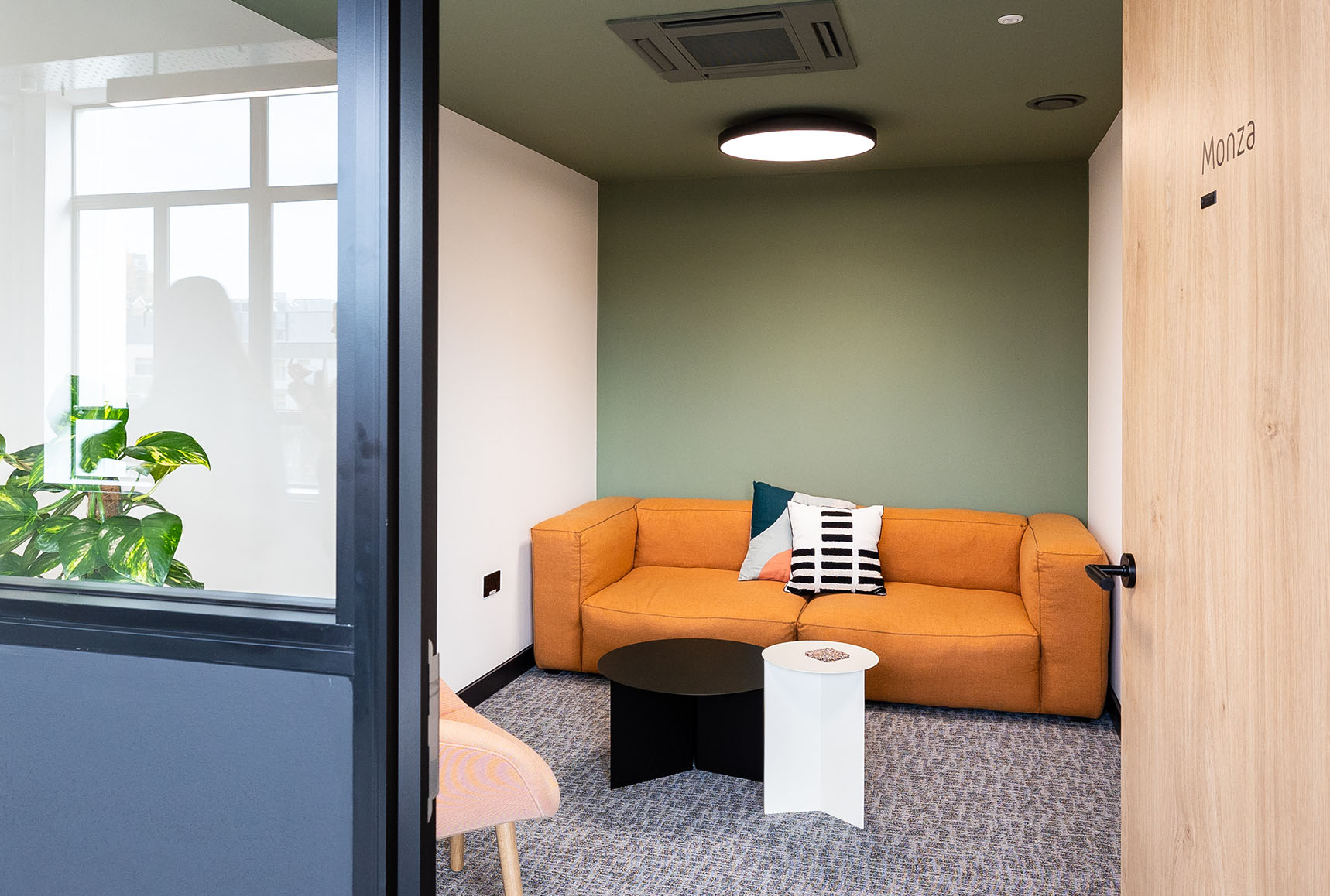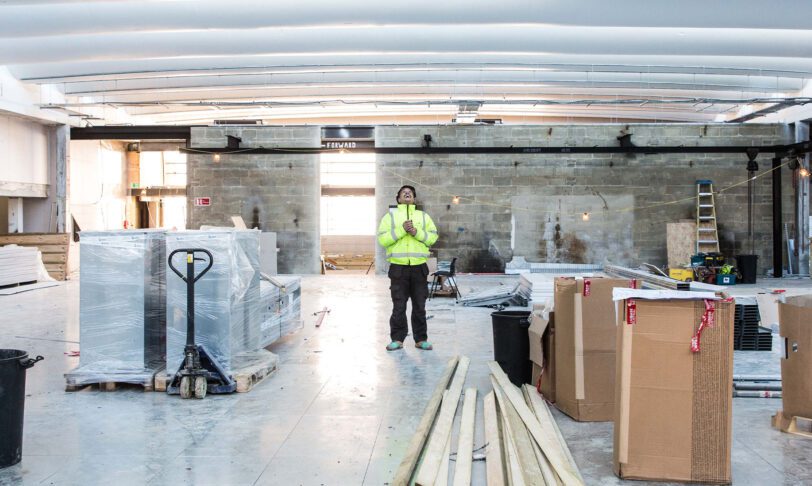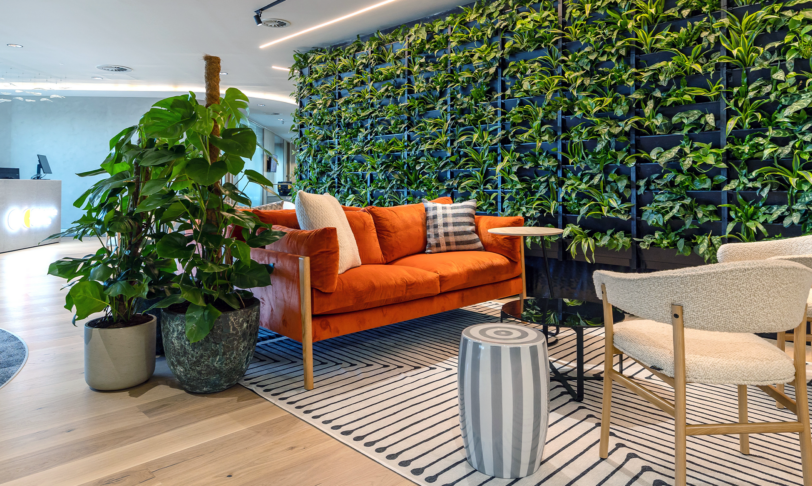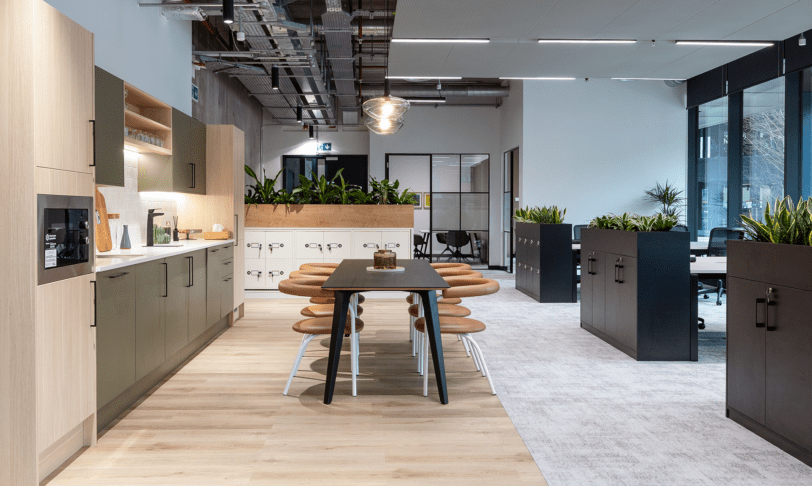10 modern office design and workspace trends
41% of the global workforce would consider switching jobs in the next year, with 55% noting that their work environment would play a role in their decisions, according to a recent survey by Microsoft.
Keeping your finger on the pulse of workplace design trends is paramount. They inform what modern workers want from their offices, based on their evolving needs.
But with so much rapid change of late, it’s hard to know which office design trends are still in demand. Are Yurt-shaped meeting rooms and Google-inspired soft play areas a thing of the past? Have we said our final goodbyes to stuffy cubicles?
We answer these questions by looking at the nature of modern office design and current workplace trends. Discover why each trend is surging in popularity and the benefits of incorporating them into your office design.
How can we define modern office design?
Flexibility
Modern design isn’t just about sleek and glossy aesthetics. Instead, it’s about recognising that people have changing and varying requirements, and configuring spaces so that each person can deliver their best while maintaining a positive work-life balance.
Your business’s needs will vary too. For example, boardrooms that are only fully occupied once in a blue moon are out, and workplaces that can easily be adapted to accommodate meetings of any size are in. Working to change your workplace processes? Modern office design accommodates that.
Scalability
Modern design isn’t just concerned with the present – it embraces the future. Planning to grow your business? Planning for scalability will ensure that your workplace isn’t overcrowded or ill-equipped to handle new teams or departments. Scaling up and down during peak and off-peak periods? Your workplace needn’t look “dead” during the off-season – if its design takes your need for scalability into account.
Adaptability
Being able to adapt and change rapidly is vital in today’s competitive and fast-paced business environment. The Harvard Business Review notes that adaptability is the “new competitive advantage.” This means having a workplace culture and design that’s geared for change.
In the words of Benjamin Disraeli, “Change is inevitable. Change is constant.” Modern office design prepares businesses to “think on their feet” and embrace change.
With the general principles having been covered, let’s look at the practical ways in which they are implemented in modern office design.
Interaction’s Ultimate Guide to Office Fit-outs [PDF Download]
A comprehensive step-by-step guide to office fit-outs. Advice on decision-making, budgets and finding a location. Download here.
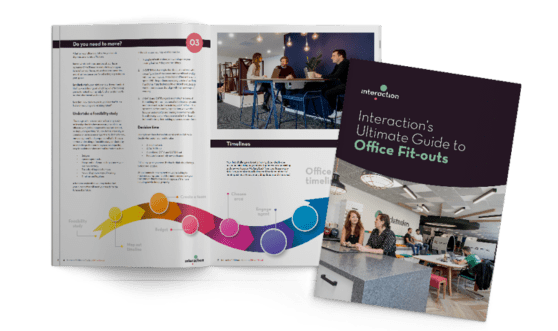
Modern workspace design trends
1. Designing for hybrid working
Nowadays, employees expect greater flexibility and like to work from home – at least, some of the time. This has led to many businesses adopting hybrid working models in which employees have office days and work-from-home days.
With a hybrid work model, there’s the flexibility that comes with remote working, alongside all the benefits of working in a shared space: the ability to learn from each other, bounce ideas off each other and the engagement that comes with feeling part of a team.
Hybrid working models impact office design in a big way. The importance of the office as a place where people work together and interact with one another is now recognised. Well-considered office designs and layouts help to foster connections between people in the workplace.
In terms of more practical requirements, offices can adapt to a hybrid work model by accommodating ‘hot desking’ rather than set-in-stone workstations, as well as having dedicated spaces (with great acoustics!) for Zoom, Google or Microsoft Teams calls.
You can see examples of how we meet the need for hybrid-work-friendly spaces in our case studies. For instance, the Institute of Physics Publishing, an organisation with over 400 employees working in eight countries, tasked Interaction with the design of a people-centric hub for their operations. Feedback from our client shows that we achieved an extraordinary transformation resulting in a more “fun, interesting, human experience.”
2. Building “destination” offices
Putting it plainly – people need to be enticed back to the office with a space that gives them something that they cannot get anywhere else. Today’s offices need to be unique and enlivening ‘destinations’ – hence the term ‘destination office’.
Imagine a workplace that offers such an enriching and fulfilling experience that talented people vie for the opportunity to be part of it. Having attracted skilled people, your workplace creates an environment in which they can thrive. Energy, creativity, and enhanced employee engagement are all at home in your “destination” workplace.
Can modern office design lead to better employee retention? In a destination workplace, it can! According to McKinsey, companies who counter the “great resignation” by creating destination workplaces stand a better chance of attracting – and keeping – top talent. Management and employee relations practices have a big role to play, but just as actors need the right backdrop, no workplace role can be enacted effectively if the scene isn’t set.
People also want to know that their employers care about their wellbeing, and modern workplace design provides evidence that they do. Apart from looking great and being comfortable, destination workplaces are environments where people feel catered to and nurtured. In essence, you care about the people who work for you and have created a space for them to do their very best.
3. Wellness rooms
With the benefits of workplace diversity having been highlighted by statistical studies, a growing number of HR leaders say inclusion is one of their five top priorities. Yet, according to a new report on diversity and inclusion by the International Labour Organization (ILO), one in four people do not feel valued at work. Planning for workplace wellbeing shows that you genuinely value your workforce.
Businesses are looking to wellness rooms as one piece of the inclusivity puzzle. When it comes to this unique workplace design trend, we’re not just talking about a room filled with yoga mats and calm lighting. Wellness spaces should be tailored to the health and wellbeing requirements of your diverse workforce. This can include:
- Nursing rooms
- Prayer rooms
- Resting rooms
The right amenities can make or break wellness spaces. For example, a nursing room for breastfeeding mothers would ideally have a recliner (as specified by HSE), a refrigerator for milk storage and a sink, plus access to Wi-Fi and reading materials.
Lighting and decoration also need to be considered for this modern office design idea. Let’s say you’re designing a wellness room for people who experience sensory overload. The room should be decorated in a soothing style so the environment doesn’t worsen the occupant’s symptoms.
Sensory overload should be considered down to the finest details. For example, our client Osborne Clarke pride themselves on having a sustainable and people-focused workplace, and have decided to eschew scented soap. Not only does this cater to people who react strongly to smells, but it also means that “greywater” (water from non-toilet plumbing systems) can be recycled. Sometimes its the smallest details that can have the biggest impact.
4. Collaborative layouts
Collaborative workspaces aren’t new, but the post-pandemic needs of employees have fueled this workplace trend. Because so many people now work from home, what they want from a day in the office has changed – a space for collaboration to get back that sense of belonging and togetherness is vital.
So, no, collaborative layouts aren’t going out of fashion any time soon. In fact, inventive ideas for this office design trend are on the rise. Especially when it comes to making the workspace fully customisable to people’s needs.
For example, we recently helped a client create collaborative workspaces by splitting its office floors horizontally and vertically. This resulted in “neighbourhoods” that could grow and shrink as required. Each neighbourhood had a similar setting; a quiet space, a meeting room and collaborative spaces. We also encouraged a cohesive yet flexible environment by sectioning areas using furniture rather than fixed partitions.
This gave occupants the freedom to mould collaborative spaces around their preferred working styles and moods. Why is this important? Most employees need a mixture of open and private spaces to balance the need for face-to-face communication with the need for recharging.
5. “Broken plan” layouts
Remember when open-plan offices were all the rage? They encourage collaboration, but research has shown that open-plan offices can be distracting and detrimental to productivity. That doesn’t mean your workspace needs to be a like-for-like reconstruction of the 1999 classic Office Space – fortunately broken-plan layouts act as a modern middle-ground that opens offices up whilst circumventing some of the bugbears of open-plan spaces.
An open floor can be zoned into distinctive areas that fulfil different functions. Floor finishes, colourways, furnishings, and split levels are among the elements that help to define spaces. They leave the office feeling open, airy, and spacious while encouraging interaction thanks to human perceptions of scale.
Want to learn more about what can be achieved by implementing a broken-plan layout? Explore an example of a broken-plan office by Interaction to see what this approach looks like.
6. Acoustics and sound management
Ever found yourself distracted or stressed out by excessive noise in the office? There may be moments when you need the sound of water cooler chatter like you need a hole in the head.
On the flip side, you’ve probably attended meetings and presentations in which you struggled to hear the speaker – so there are times when we need sound to carry too.
Current office trends recognise the importance of acoustics and sound management in offices. Approaches include the provision of quiet spaces that shut out sounds from the outside and soundproof spaces for confidential calls and meetings. And, when you really want everyone to be able to hear clearly, good design can help sound to carry.
There’s more to sound management than you might have imagined. For example, sound can travel along ductwork, and the reverberation of sound off hard surfaces can result in an unnecessarily noisy and distracting workplace. Analysis of acoustics in office layouts have therefore become an important element in modern office design.
7. Flexible workplace design
Flexibility is one of the key principles behind modern office design ideas. There are two main perspectives to accommodate: your business’s current and future needs, and the needs of your employees.
From the people perspective, we all have preferred ways to work and differing environments in which we are able to deliver our best depending on what we’re busy with. Sometimes, we need to be focused – and the space that promotes focus will differ from individual to individual. Sometimes, we need to be creative and bounce ideas around, and of course, being able to choose where you’ll work on tasks gives you a sense of freedom.
Your business also needs flexibility. You won’t want to redesign your office or jam in an extra desk at random every time you appoint a new employee, for example. There may be days when you want to hold an office “town hall,” and there will be others when it’s business as usual and the “town hall” space transforms itself to adapt to day-to-day work.
We were thrilled to assist Fleetcor in designing a welcoming workplace that accommodates both the business’s needs and the various ways its people like to work. We divided the space into flexible “neighbourhoods” that accommodate a variety of working styles. And, because the elements dividing these neighbourhoods are moveable, scalability is part of the package.
8. Sustainable offices
This impactful workplace design trend is here to stay. Not only does it help companies bolster their ESG and CSR credentials, but it often helps people feel that they are part of a company that is concerned with making a difference – which can do wonders for employee engagement. There are several ways in which sustainability can be incorporated into modern office design:
- Use sustainably-sourced furniture and decor
- Install water-restricted taps in your kitchens and bathrooms
- Install a dual plumbing system to recycle water for toilet use
- Make better use of natural light using glass walls
- Add interior insulation and seal gaps around windows and doors
- Use natural ventilation over air-conditioning units
- Add bicycle storage units and Active Travel facilities
Discover more tips on making your workspace sustainable in our office fit-out guide.
A sustainable office will help you reduce your environmental impact and attract talent: over half (53%) of the UK’s workforce say sustainability is an important factor in choosing a company to work for, according to Anthesis’ recent study.
Plus, it pays to have a greener office. According to Carbon Trust, cutting energy costs by 20% has the same effect on the bottom line as a 5% increase in sales.
9. Designing for Neurodiversity
Neurodiversity appreciates that everyone’s brains operate a little differently. Embracing this in the workplace means all your people can thrive, whether they have ADHD, dyslexia or autism.
More and more businesses are looking to accommodate their neurodiverse teams with modern office designs that make them feel more comfortable. This brings out the best of their team’s exceptional talents, such as creative storytelling and pattern recognition.
One of the most effective ways to realise this workplace trend is by offering a variety of settings for your team members. This can include breakout spaces for socialising, specialised rooms for relaxation and flexible cubicles for more focused work.
It’s also good to consider how all the elements in your space, including your furniture, work as a whole. Do they create a reassuring sense of order? Is it easy for workers to orient themselves? Small details like these can have a real impact on neurodiverse minds.
10. Smart Offices
By 2025, the smart office global market size is projected to hit $57.05 billion, proof that this workplace design trend should be on everyone’s radar. But what is a smart office?
It’s an office that uses smart tech, such as the Internet of Things, to shape the environment around those who use it. Systems within the office – like those controlling lighting, temperature and ventilation – collect, share and communicate data, enabling adjustments to accommodate the needs of the people using the space.
In this sense, smart offices improve the wellbeing of employees and visitors, creating healthier environments that are comfortable and dynamic. Smart offices can also drive down energy costs. In a global Quocrica study, 57% of the 260 organisations surveyed said they were investing in smart building technology because of the potential long-term cost savings.
Chat with Charlie
Get in touch with Charlie, our Relationships Manager to discuss how we could revolutionise your space.
Email: [email protected]
All general enquiries
Phone: 01225 485 600
Email: [email protected]
Or sign up for our newsletter here

What should you consider with modern office design?
If you’re exploring new modern office designs, starting your research here was a smart move. Now you know which workplace trends are worth taking seriously. But which one is right for your project?
It all depends on the people occupying your space, the kind of culture you want to inspire, and what’s in store for your business’ future. Thinking about these things helps you picture what your ideal workspace should look like. Our top ten office design trends will then fall naturally into your future office designs. To recap, they are:
- Hybrid working offices
- Destination offices
- Wellness rooms
- Collaborative layouts
- Broken plan layouts
- Acoustics and sound management
- Flexible workplace design
- Sustainable offices
- Neurodiverse workspaces
- Smart offices
Need more inspiration? Pour yourself a coffee and spend some time looking at our work. You’ll come away with plenty of exciting modern office design ideas.
Alternatively, to find out more about our office design and fit-out services, why not chat with Charlie or call us on 01225 485 600 to speak to a member of our team?
